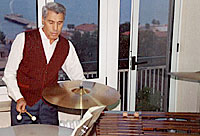|
NEW STUDY OF THE FUNDAMENTAL TECHNIQUES |

|
“The percussion instrument teaching methods have changed. First of all, it was necessary to adapt the technique to the new instruments, which have undergone a transformation process from the sound point of view, because of the use of synthetic material.
Secondly, many teaching experiences and a detailed analysis of the results have made it possible to establish the natural procedures for learning how to play these instruments". These statements, contained in the preface of the book "Il suono della percussione" (Milan 1982) are extremely valid today. The evolution of the percussion instruments should be matched by an evolution of the techniques and the study methods, the same as the other instruments, which have evolved a lot recently. Keyboards, especially the marimba, the timpani and the drums have reached a level of interpretation which was unthinkable some decades ago. Therefore, executions which were believed to exploit all the available techniques are today considered within everybody’s reach. Unfortunately, the continuous transformation process of the music language is not matched by an updating of study programmes and methodologies. This means that at the moment a wide gap exists between the traditional way of studying and the practice of the instrument. The study of the main technique, for example, which has been adopted for decades, requires lots of changes, as the exercises confine themselves to the usual rhythmical formula "on the downbeat" and speed is only at the interpreter’s discretion. If you have always studied the basics (rudiments) in a traditional way, try and execute a simple single "paradiddle", in an “odd” tempo (with accents different from the usual) and you could have a surprise! To make the study of the fundamentals more complete, shortening learning time, you have to change the method of study. Personally, I use technical syntheses based on all-inclusive readings. It has to do with a few exercises, of only one page each, with which you study technique, rhythm and reading all at the same time. Example: (click here) A good part of these exercised have been put into the video, “Percussion and drums school” and can be studied with an entertaining karaoke. Which means that you can follow the notation on the video (while you're playing) because the coloring of the notes is perfectly synchronized with the music. From a strictly technical point of view, you study: rhythmic combinations from two to fifteen strokes, measured rolls in single, double and triple strokes (with attack on the beat and the up-beat), single, double and triple paradiddles, the new paradiddle with final triple stroke and flam. This type of study not only includes the technical aspect, but also the aspect of future musical practice. In fact, you should not underestimate the advantages that can be derived both in habituating yourself to change, depending on the notation, from division accents to subdivision accents, as well as learning to calculate by ear the groups and measured rolls that make up the rhythmic base of so many classical symphonies performed on the timpani.  |